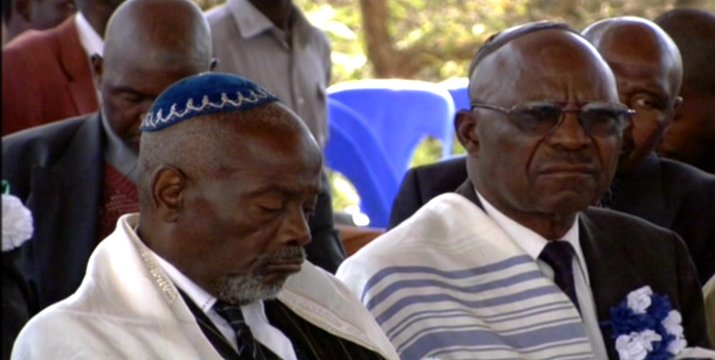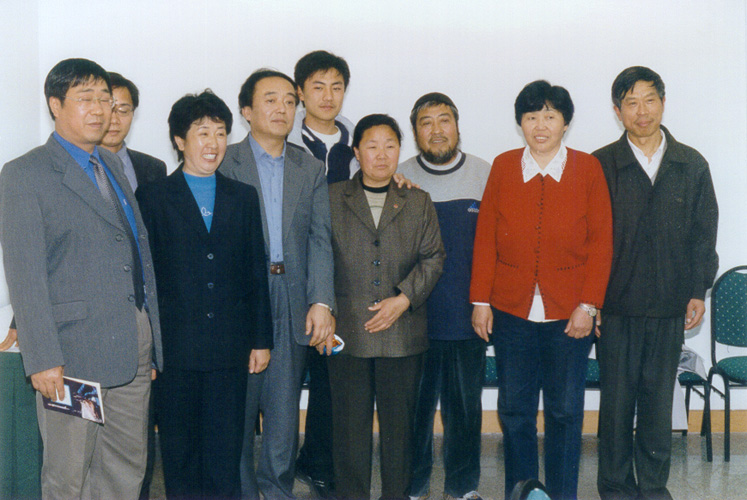
Group in Africa Has Jewish Roots, DNA Indicates
By NICHOLAS WADE
 he Lemba, a Bantu-speaking people of southern Africa, have a tradition that they were led out of Judea by a man named Buba. They practice circumcision, keep one day a week holy and avoid eating pork or piglike animals, such as the hippopotamus.
he Lemba, a Bantu-speaking people of southern Africa, have a tradition that they were led out of Judea by a man named Buba. They practice circumcision, keep one day a week holy and avoid eating pork or piglike animals, such as the hippopotamus. Several groups around the world practice Judaic rites or claim to be descended from Biblical tribes without having any ancestral Jewish connection. And there is no Buba in the records of Jewish history.
But the remarkable thing about the Lemba tradition is that it may be exactly right. A team of geneticists has found that many Lemba men carry in their male chromosome a set of DNA sequences that is distinctive of the cohanim, the Jewish priests believed to be the descendants of Aaron. The priestly genetic signature is particularly common among Lemba men who belong to the senior of their 12 groups, known as the Buba clan.
The discovery of the Lemba's Jewish ancestry has come about through the intertwining of two unusual strands of inquiry. One was developed by geneticists in the United States, Israel and England who wondered what truth there might be to the Jewish tradition that priests are the descendants of Aaron, the elder brother of Moses.
The other strand was provided by Dr. Tudor Parfitt, director of the Center for Jewish Studies at the School of Oriental and African Studies in London. Parfitt, who has done research among the Lemba for 10 years, believes that he has discovered Senna, the mysterious northern city from which Lemba tradition maintains they came, and that he can retrace their steps from Senna to Africa, maybe a thousand years ago.
The genetic side of the story began when Dr. Karl Skorecki, a kidney expert at the Technion-Israel Institute of Technology, was sitting in a synagogue in Toronto. Skorecki, who is a priest, wondered if a fellow cohen who was being called to attend the first Torah reading might be distantly related to him, as the tradition of priestly descent from Aaron implied.
He called Dr. Michael F. Hammer of the University of Arizona, an expert who studies the genetics of human populations through the male or Y chromosome. Unlike the other chromosomes, the genetic material on the Y chromosome is not shuffled every generation, obscuring the lines of individual descent. Y chromosomes are bequeathed from father to son, more or less unchanged apart from the occasional mutation.
The mutations are particularly helpful for reconstructing population history because each lineage of men has its own distinctive pattern of mutations. It was a Y chromosome study last year that confirmed the oral tradition among the descendants of the slave Sally Hemings that their ancestor was Thomas Jefferson, the nation's third President.
Hammer, Skorecki and their colleagues reported in 1997 that they had analyzed the Y chromosomes of priests and lay Jews (priests, a hereditary caste, are different from rabbis and also from Levites). They found that a particular pattern of DNA changes was much more common among the priests than among laymen. The pattern was equally recognizable in Ashkenazic and Sephardic priests, even though these two branches of the Jewish population have long been geographically separated.
A colleague in Hammer's and Skorecki's research was Neil Bradman, a businessman who is now chairman of the Center for Genetic Anthropology at University College, London. Bradman set about making a wider study of Jewish populations around the world through the lens of the Y chromosome technique.
One recruit to Bradman's project is David B. Goldstein, a population geneticist at Oxford University in England. Goldstein set about refining Hammer's work so as to develop a better genetic signature of Jewish populations.
"The problem is there has been intermingling with host populations, and that has obscured their common ancestry," Goldstein said.
He looked at a set of three Y chromosome sites with stable genetic mutations and six sites at which mutations occur quite often, a mix designed to give good resolution between similar Y chromosomes during historical times. The mutations are all at sites that lie outside the genes, and thus do not contribute in any way to the individual's physical makeup.
He found a particular set of genetic mutations at these nine sites that was strongly associated with the priestly caste, not so common among lay Jews, and very rare among non-Jewish populations. Unlike forensic DNA markers, which are chosen to be almost wholly specific to individuals, this cohen-associated genetic signature cannot be used to say who is or who is not a priest. But it is highly diagnostic of whether a population has Jewish ancestry, Goldstein said.
He finds that 45 percent of Ashkenazi priests and 56 percent of Sephardic priests have the cohen genetic signature, while in Jewish populations in general the frequency is 3 to 5 percent.
Some of his subjects had the cohen genetic signature but with slight variations caused by mutations. From the pattern and number of mutations, Goldstein was able to calculate when the present day bearers of the cohen genetic signature and its variations last shared a common ancestor. This date, when all the branches of the family tree coalesce into a single trunk, has a wide range of uncertainty and depends on several assumptions, like the number of years in a human generation and the rate of mutation. But assuming 25 years to a generation on average, Goldstein calculated the coalescence time as 2,650 years ago, or 3,180 years with a 30-year generation time.
Though they are only rough, these dates make an evocative match with the Jewish tradition that Moses assigned the priesthood to the male descendants of his brother Aaron after the Exodus from Egypt, believed to have occurred some 3,000 years ago. Goldstein and colleagues published this conclusion last July.
"In studying the priesthood, we happened into this tool for distinguishing Jewish from non-Jewish populations," Goldstein said. As part of Bradman's project on the relationship of Jewish populations, he then tested DNA samples collected from the Lemba. And last month, at a conference on human evolution held at the Cold Spring Harbor Laboratory in Long Island, Goldstein reported that 9 percent of Lemba men carried the cohen genetic signature, and of those who said they belonged to the Buba clan, 53 percent had the distinctive sequences. These proportions are similar to those found among the major Jewish populations.
Because the cohen genetic signature is rare or absent in all non-Jewish populations tested so far, the findings support the Lemba tradition of Jewish ancestry. Goldstein said his findings would be published in the American Journal of Human Genetics.
How did a Jewish priestly male chromosome come to be found in a black, Bantu-speaking people that looks very much like its southern African neighbors? Parfitt, who believes he has found the answer, first came across the Lemba while giving a lecture in Johannesburg about Ethiopian Jews. Some people in the audience wearing yarmulkes told him they, too, were Jewish.
Parfitt visited their homes, which are in northern South Africa and Zimbabwe. Many of the Lemba, who number more than 50,000 people, are Christians, but they see no contradiction in professing Judaism, too. He learned that they had an enigmatic tradition about their origin: "We came from the north, from a place called Senna. We left Senna, we crossed Pusela, we came to Africa and there we rebuilt Senna."
Parfitt said that he was later traveling in the Hadramawt region, a former site of Jewish communities in Yemen, and mentioned the Lemba tradition of Senna to the religious leader of the holy city of Tarim. The leader was surprised to hear it because, he told Parfitt, there was a nearby village called Senna.
"So I went off to find Senna," Parfitt said. "It's very remote and had never been visited by anyone before. The local tradition is that centuries ago the valley had been very fertile, irrigated by a dam, the ruins of which are still there. And then the dam burst, they think about a thousand years ago, and the people fled."
There is a valley that leads from Senna to a port on the Yemeni coast called Sayhut. If the winds are right, a ship from Sayhut could reach southern Africa in nine days, Parfitt said. And the valley that leads from Senna to Sayhut is called the Wadi al-Masilah. Parfitt believes that Masilah may be the "Pusela" of the Lemba oral tradition.
The Lemba have clan names like Sadiqui and Hamisi that are "clearly Semitic" and that are also found in the eastern Hadramawt, Parfitt said. Parfitt, who has described his work on the Lemba in a recent book, "Journey to the Vanished City" (Phoenix, London), said he had been excited to hear of Goldstein's genetic results confirming the Lemba tradition.
http://partners.nytimes.com/library/...ish-genes.html
En faisant une petite recherche au net,on trouve qu'il ya aussi des chinois &indiens d'origine juive.
http://en.wikipedia.org/wiki/Kaifeng_Jews

http://en.wikipedia.org/wiki/Indian_Jews




Commentaire